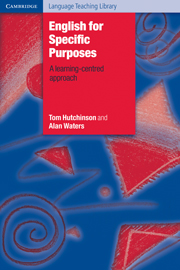9 - Materials evaluation
Published online by Cambridge University Press: 03 May 2010
Summary
We must grant the artist his subject, his idea, his donne: our criticism is applied only to what he makes of it.
(Henry James: The Art of Fiction)Having completed your needs analysis and course design, you must now decide what you are going to do with it. One option, of course, is to decide that the whole thing is completely impossible and throw the results in the wastepaper bin. Assuming, however, that you wish (or have) to proceed, there are three possible ways of turning your course design into actual teaching materials:
a) Select from existing materials: materials evaluation.
b) Write your own materials: materials development.
c) Modify existing materials: materials adaptation.
In this and the following chapter we shall look at the first two options: materials evaluation and materials writing. The third option is a combination of the first two. So, if this is your choice, you will need to use both processes. Although we shall look at evaluation and development separately, they are complementary activities. The materials writer can learn a lot in terms of ideas and techniques from evaluating existing materials. Similarly, writing materials makes you more aware of what to look for in materials written by other people – and also more sympathetic to the efforts of other materials writers!
Why evaluate materials?
Evaluation is a matter of judging the fitness of something for a particular purpose. Given a certain need, and in the light of the resources available, which out of a number of possibilities can represent the best solution? Evaluation is, then, concerned with relative merit.
- Type
- Chapter
- Information
- English for Specific Purposes , pp. 96 - 105Publisher: Cambridge University PressPrint publication year: 1987



